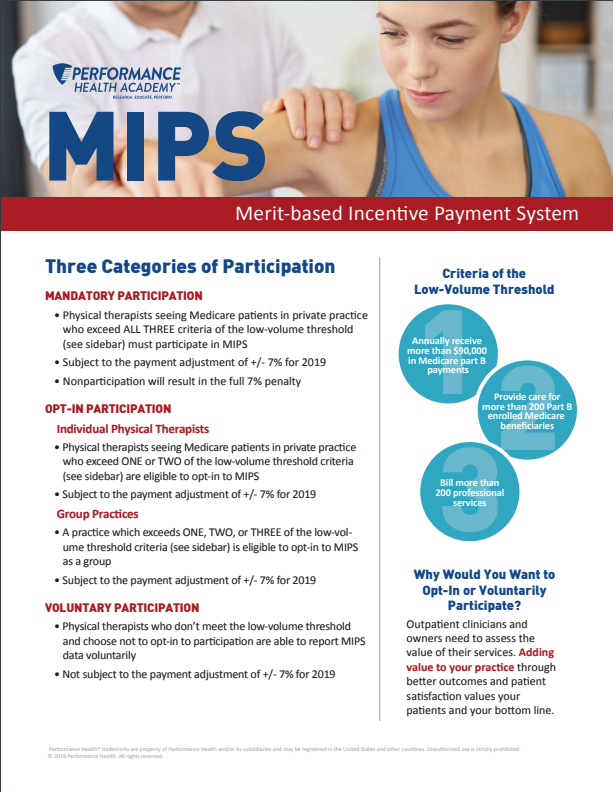The new MIPS reimbursement system may change how outpatient clinicians and owners think about documentation, home programs, and the clinical experience to bring value to their practice and their patients.
In January 2019, Medicare Part B payment in outpatient PT will add eligible PTs and OTs to Medicare’s Quality Payment Program (QPP). For years, reimbursement has moved from ‘fee for service’ to a ‘value-based’ model, where better outcomes are favored over healthcare costs:


Some therapists have participated in Medicare’s value-based system (PQRS) since 2007. However, PQRS has been replaced by the “Merit-Based Incentive Payment System” (MIPS). Eligibility to participate is based on specific criteria for outpatient practitioners, but they may voluntarily participate if not eligible now to help prepare when it’s mandatory for all PTs and OTs. Outpatient providers billing over $90,000 in Medicare Part B will be eligible.
A benefit of participating is to increase reporting and outcomes by providing incentive payments. But providers may also face penalties! Providers with lower quality outcomes may actually see a decrease in reimbursement. Incentive payments and penalties can range from +/- 4% and will increase to +/- 9% by 2022. Adjustments are made based on a clinician’s total annual performance score. Two key reporting areas are quality and clinical improvement.
Is Your Documentation Ready?
Participants will be required to use electronic health records (EHR) to participate. A certified EHR will likely be required after 2019 for group practices over 15 practices. The APTA Physical Therapy Outcomes Registry is an option for MIPS reporting. It’s qualified as a CMS clinical data registry (www.ptoutcomes.com) and is EHR-agnostic, meaning it’s compatible with any common EHR. For providers, one advantage is that the APTA PT Outcomes Registry collects quality outcomes data specific to physical therapy. Collecting additional information may help explain clinical results to better represent the quality of care provided.
Are You Emphasizing Home Exercise Programs?
A key component to patient outcomes isa successful home exercise program. Home exercise compliance is associated with better outcomes. With the number of clinic visits decreasing, it’s more important than ever for patients to have a home exercise program…and with MIPS it’s even more important that they are compliant for better outcomes. Here are a few important points to remember to improve your home exercise program prescription:
We may have to bring in a nutritionist because the metabolic demands of someone who's injured is totally different from someone who's not. We need to make sure that they're optimizing their body composition during the entire process and they don't lose a ton of muscle mass. If they're not sleeping because they're in pain, we may want to bring in a sleep specialist. If they're in a lot of pain, we don’t need to go down the pharmaceutical route and instead might utilize acupuncture or other pain relieving modalities to help with pain control.
- Be sure each patient has a home exercise program starting with the first or second visit
- Ensure patients have access to the products/equipment they need for their program
- Include patient education and behavioral change strategies in home program prescriptions
- “Assess and Progress” home exercise programs at every visit
- Document HEP compliance (remember that some patients over-report their compliance!)
Have You Optimized Your Customer Experience?
Compliance with clinic visits is also associated with better outcomes. As the number of insurance-approved visits decrease in an effort to reduce costs, clinicians need to make the most of patient visits. The period of time between visits is also increasing. Obviously, assessing and progressing the home program should be emphasized with each visit. While the patient-clinician relationship is important to outcomes as well, treating a patient as a customer rather than only a patient can help retain patients and create return customers.
Patient satisfaction should be a high priority for patient retention! Analyze everything associated with your patient’s visit experience in the front office, clinic, and community: referral, scheduling, billing, paperwork, communications, and discharge surveys. And in today’s digital world, your online reviews can speak volumes about your patient satisfaction and your reputation! Software solutions for patient engagement can also be helpful tools for outpatient clinics.
With MIPS approaching, outpatient clinicians and owners need to assess the value of their services. Adding value to your practice through better outcomes and patient satisfaction values your patients and your bottom line.
Click here for the full PDF and get a quick overview on MIPS
